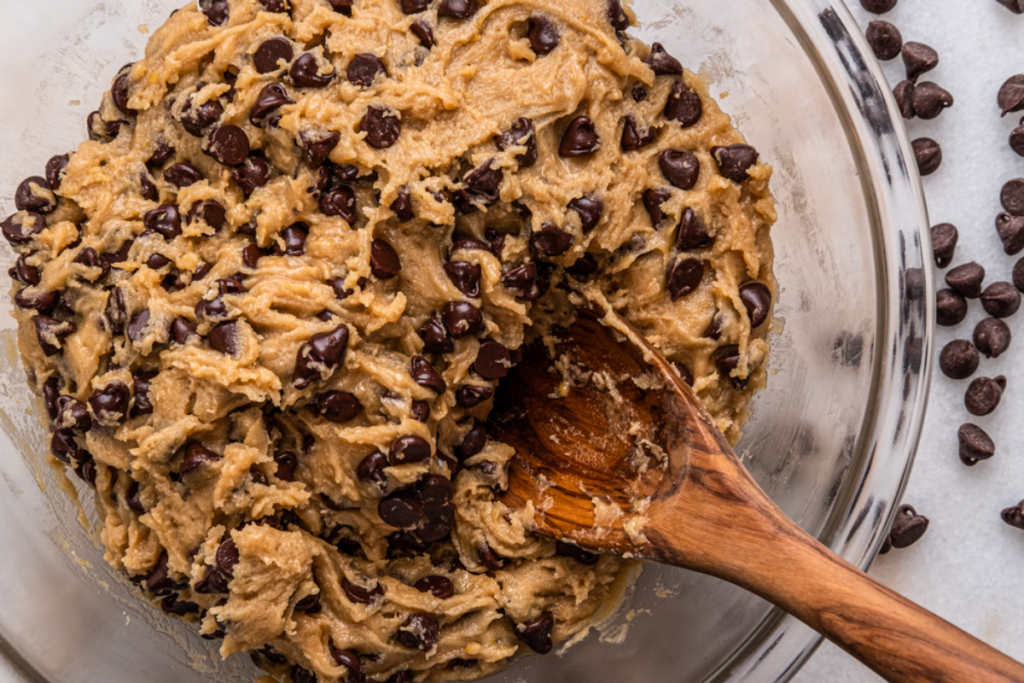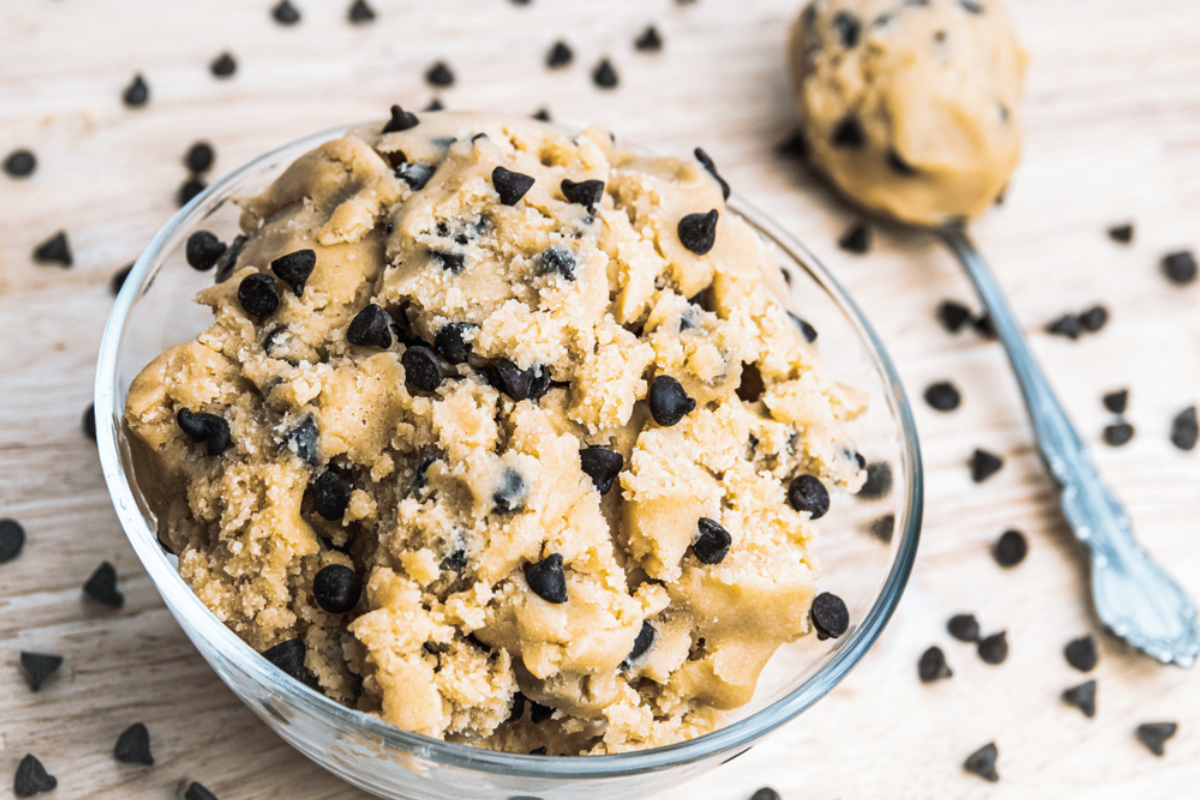Cookies are a beloved treat, enjoyed by people of all ages, but when it comes to making them, you might wonder: What is the difference between cookie batter and cookie dough? While the terms “batter” and “dough” are often used interchangeably, they actually refer to two distinct textures and consistencies in baking. Understanding the difference between cookie batter and cookie dough can help you achieve the right results when making different types of cookies. In this guide, we’ll dive into the characteristics that set them apart, the science behind each, and how to work with both to make delicious cookies.
Defining Cookie Batter and Cookie Dough
Before we explore the nuances, let’s start by defining each term clearly to understand what is the difference between cookie batter and cookie dough.
What Is Cookie Dough?
Cookie dough is a thick, moldable mixture that’s solid enough to be rolled, scooped, or shaped by hand. It holds its shape well, which is why cookie dough is often used to make cookies that need to retain a specific form while baking, such as chocolate chip cookies, sugar cookies, or snickerdoodles. Cookie dough is typically dense, allowing it to spread slowly as it bakes, producing cookies that are chewy or slightly crisp.
What Is Cookie Batter?
Cookie batter, on the other hand, is a more liquid or pourable mixture. It has a thinner consistency than dough and often requires a spoon or piping bag to transfer it onto the baking sheet. Cookie batter is used for cookies that have a lighter, airier texture, such as certain types of drop cookies, madeleines, or wafer cookies. Batter tends to spread more quickly in the oven, resulting in thinner, crisper cookies.
Now that we’ve defined them, let’s break down what is the difference between cookie batter and cookie dough by looking at ingredients, texture, and usage.
Key Differences Between Cookie Batter and Cookie Dough
To fully grasp what is the difference between cookie batter and cookie dough, we need to explore several factors that distinguish them, including their consistency, ingredients, and baking processes.
1. Texture and Consistency
One of the most noticeable differences between cookie batter and cookie dough is the texture.
- Cookie Dough: As mentioned, cookie dough is thick and firm. You can roll it into balls, cut it into shapes, or drop it onto a baking sheet using a spoon. The consistency of cookie dough allows it to hold its shape during baking, which is ideal for cookies like chocolate chip or sugar cookies.
- Cookie Batter: In contrast, cookie batter is much looser and more liquid-like. It’s often too thin to shape with your hands and requires pouring or spooning onto the baking surface. Cookie batter tends to create cookies that spread out more during baking, resulting in thinner, crisper cookies.
2. Ingredients
Both cookie dough and cookie batter share similar basic ingredients—flour, sugar, butter, eggs, and leavening agents—but the proportions of these ingredients can vary significantly.
- Cookie Dough Ingredients: Cookie dough typically contains more flour and less liquid, which contributes to its thicker texture. The higher flour-to-liquid ratio helps create a dense, chewy cookie that holds its shape.
- Cookie Batter Ingredients: Cookie batter, on the other hand, may contain more liquid ingredients like milk, water, or melted butter. These extra liquids give the batter its looser consistency. The addition of more liquid allows for a lighter texture, which is ideal for delicate, crispy cookies.
3. Usage in Different Types of Cookies
The type of mixture you use—dough or batter—depends largely on the type of cookie you’re aiming to make. Here’s where the difference between cookie batter and cookie dough becomes clear in terms of what cookies they are used to create.
- Cookies Made with Dough: Cookies like chocolate chip, peanut butter, shortbread, and sugar cookies all use cookie dough. These cookies require a denser mixture that can hold its shape, making them ideal for rolling, cutting, or scooping.
- Cookies Made with Batter: For lighter, crisper cookies, batter is the way to go. Cookies like tuile, madeleines, and lace cookies use cookie batter, as they require a more liquid consistency to spread thinly and bake evenly.
How to Work with Cookie Dough
When learning what is the difference between cookie batter and cookie dough, it’s helpful to know the best ways to handle cookie dough. Let’s explore how to prepare, shape, and bake with cookie dough.
1. Preparing Cookie Dough
To make cookie dough, the basic process involves creaming softened butter with sugar, then adding eggs and flour to form a thick, moldable mixture. Depending on the type of cookie, you might also add chocolate chips, nuts, or spices to the dough before shaping it.
Most cookie dough requires chilling before baking. Chilling helps solidify the butter, which prevents the cookies from spreading too much during baking and allows for a more controlled rise.
2. Shaping Cookie Dough
Because cookie dough holds its shape well, it’s easy to mold into various forms. Here are a few ways to shape cookie dough:
- Drop Cookies: Use a cookie scoop or spoon to drop dough balls onto a baking sheet. This method is commonly used for chocolate chip or oatmeal cookies.
- Rolled Cookies: Roll out the dough with a rolling pin and cut it into shapes using cookie cutters. This is ideal for sugar cookies.
- Slice-and-Bake Cookies: Shape the dough into a log, chill it, and then slice it into rounds. This method works well for shortbread or pinwheel cookies.
3. Baking Cookie Dough
When baking cookies made from dough, it’s important to keep an eye on the baking time. For chewy cookies, pull them from the oven just as the edges turn golden. For crispier cookies, let them bake for an extra minute or two.

How to Work with Cookie Batter
Now that we’ve covered dough, let’s dive into cookie batter and how to work with this more liquid mixture.
1. Preparing Cookie Batter
Cookie batter is usually prepared by mixing wet ingredients (butter, sugar, eggs, and any liquids) with dry ingredients (flour, baking powder, and spices). The process is similar to making cake batter, but the end result is typically thinner, with a looser texture than cookie dough.
Because cookie batter is more liquid, there’s no need to chill it before baking. In fact, cookie batter needs to be baked soon after mixing to ensure it spreads correctly in the oven.
2. Handling Cookie Batter
Since cookie batter doesn’t hold its shape like dough, you’ll need different methods for handling and shaping it. Here are a few common techniques:
- Spoon or Pour: Cookie batter can be spooned or poured directly onto a baking sheet, allowing it to spread naturally during baking.
- Piping: For precision, some cookies made with batter are piped onto the baking surface using a piping bag. This method is ideal for cookies like madeleines or spritz cookies.
3. Baking Cookie Batter
Cookies made from batter bake quickly due to their thin consistency. They often spread widely on the baking sheet, so it’s important to leave enough space between each portion of batter. Keep a close eye on the baking time, as these cookies can go from perfectly crisp to overdone in just a minute.

Common Mistakes to Avoid with Cookie Dough and Cookie Batter
Whether you’re working with cookie dough or cookie batter, there are a few common mistakes that can affect the final outcome. Understanding these pitfalls will help ensure you get the perfect cookie every time.
1. Overmixing the Dough or Batter
One of the most frequent mistakes is overmixing. Overmixing cookie dough or batter can lead to tough, dense cookies. When mixing, aim to combine the ingredients just until everything is incorporated—especially after adding the flour. Overmixing can cause too much gluten development, resulting in a chewy or hard cookie.
2. Not Chilling Cookie Dough
If a recipe calls for chilling cookie dough, it’s essential not to skip this step. Chilling helps firm up the dough, allowing the cookies to hold their shape during baking. Without chilling, cookies may spread too thin and lose their intended texture.
3. Misjudging Baking Time
Baking time can make or break a batch of cookies. For dough-based cookies, pulling them from the oven at just the right moment ensures they’ll be soft and chewy. For batter-based cookies, you’ll want to keep a close eye on the bake time, as these cookies tend to bake faster due to their thin nature.
Frequently Asked Questions About Cookie Dough and Cookie Batter
Can You Turn Cookie Dough into Cookie Batter?
Cookie dough cannot be easily transformed into cookie batter, as they have different ingredient ratios and textures. However, you can adjust some dough recipes by adding more liquid to create a batter-like consistency, but it’s best to follow a recipe designed specifically for batter.
Which Is Easier to Work With: Dough or Batter?
Cookie dough is typically easier to handle because it holds its shape well and can be rolled, scooped, or shaped easily. Cookie batter, being thinner, requires more care when handling, but it works beautifully for delicate, thin cookies.
Do All Cookies Start with Dough or Batter?
Almost all cookies begin with either dough or batter, but the specific type depends on the recipe and desired result. Dough is used for sturdier cookies that need shape, while batter is ideal for thinner, crispier cookies.
Can cookie dough be converted into cookie batter?
Converting cookie dough into cookie batter isn’t a straightforward process. Dough and batter have different ratios of dry to wet ingredients, which give them their distinct textures. While you can add more liquid (such as milk or water) to soften dough into a batter-like consistency, it might not result in the same cookies as if you had started with a batter recipe. If you’re aiming for thinner, crisper cookies, it’s best to follow a specific recipe for cookie batter.
Why do some cookie recipes use dough while others use batter?
The choice between dough and batter depends on the texture and shape desired for the cookies. Dough is thicker and holds its shape well, making it ideal for cookies that require definition, such as chocolate chip or sugar cookies. Batter, being more liquid, spreads more during baking and is used for cookies that are meant to be thinner, lighter, or more delicate, such as lace cookies or madeleines. The different consistencies lead to different final results.
Conclusion: What Is the Difference Between Cookie Batter and Cookie Dough?
So, what is the difference between cookie batter and cookie dough? It ultimately comes down to consistency, ingredient ratios, and how they are used in the baking process. Cookie dough is thick, dense, and easy to mold or shape by hand. It is commonly used for cookies that need to hold their form, such as chocolate chip, sugar, and oatmeal cookies. Dough offers flexibility in terms of shaping, whether it’s rolled, scooped, or even sliced, and is often chilled to enhance the texture and control the spread during baking.
Cookie batter, on the other hand, is much thinner and more liquid in consistency. It’s ideal for cookies that are meant to be light, airy, or crispy. Batter tends to spread more quickly and evenly during baking, producing delicate cookies like lace cookies or madeleines. Because of its liquid-like nature, cookie batter is often poured, piped, or spooned onto a baking sheet, allowing it to naturally take its shape in the oven.
By understanding what is the difference between cookie batter and cookie dough, you can approach baking with more confidence, knowing how to choose the right method for your cookies. Whether you’re aiming for soft and chewy or thin and crisp, mastering both types will help you create the perfect cookie every time. Now that you know the differences and best practices, it’s time to grab your ingredients and start baking delicious cookies!
